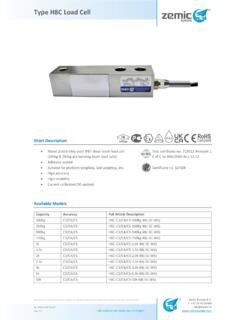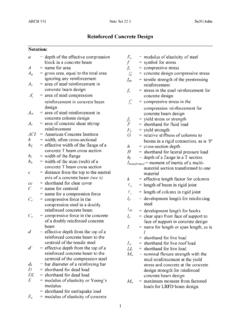Transcription of Load Cell Application and Test Guideline
1 Scale Manufacturers Association load Cell Application and Test Guideline Approved April 2010 Scale Manufacturers AssociationPO Box 26972 Columbus, Ohio43226-0972 Phone: (866) 372-4627E-mail: load Cell Application and Test Guideline Table of Contents Section 1 Purpose 2 Scope 3 Introduction to load cells 4 load Cell Specifications 5 Test Procedures Appendices I Comparison of load cell specifications II load cell functional testing III load cell Terminology References The following individuals, representing the membership of the SMA, contributed to this standard: Cardinal Scale Manufacturing Company Steve Patoray HBM Inc.
2 Jeff Robidoux Hobart Nigel Mills Mettler-Tole do Inc. Darrell Flocken Mettler-Toledo Inc. Tom Leahy Revere Transducers Inc. Jan Kersten Tedea-Huntleigh Inc. Quenton Olson Avery Weigh-Tronix Inc. Kevin Fruechte 1. Purpose It is the purpose of this Guideline to promote greater understanding between manufacturers and users of load cells by establishing uniform terminology, method of specification, and test procedures for load cells . A primary objective of the standard is the establishment of simple and readily understandable definitions. As much as possible, terminology has been defined in a manner such that the term can be expressed quantitatively and in a straightforward manner.
3 It is also an objective of the standard to establish a common term or title for each performance characteristic relating to load measuring devices. Where several terms pertaining to the same definition are in common usage, preference will be indicated by listing the definitions under the preferred term. All terms for which a definition has been provided, with the exception of load and load cell , are shown bold throughout to facilitate referencing the definitions. It will be noted that the term accuracy has been used sparingly since its meaning has become too general. When applied to measuring devices, this term is confusing since it is seldom known which specific errors are included.
4 2. Scope This standard provides recommended terminology and definitions pertaining to load cells used for performing accurate measurement of weight and force. Whenever possible the terminology and definitions have been established to apply as broadly as possible to all load cells regardless of technology employed. However, the main focus has been on stress or strain sensing load cells and specifically strain gage load cells and terminology pertaining exclusively to other load cell types (mechanical, hydraulic, pneumatic, etc.) has not been included. The terminology and definitions in this document refer to load cells only.
5 No attempt has been made to cover related instrument systems terminology. It is recognized that there is additional transducer terminology that could apply to load cells . However, the list of definitions in Appendix III has purposely been limited to those terms frequently used and necessary in the general use and Application of such devices. 3. Introduction to load cells A load cell is a device that is used to measure weight or force. W hen a force is applied to it in a specific manner, a l oad cell produces an output signal that is proportional to the applied force. Strain gage load cells are at the heart of the majority of weighing and force measurement devices produced today.
6 One end of a load cell is typically supported on a rigid structure while the other end supports a load -receiving device through which the load or force is applied. load cells can be used individually or in combinations in weighing devices, as dictated by the geometry of the object to be weighed. Strain gage load cells are by far the most common form of load cell commercially available today, and are briefly described here. F igure 1 illustrates a t ypical metallic foil strain gage. Figure 1: Metallic foil strain gage This consists of a metallic foil etched into parallel grid lines forming a circuit between the solder pads that are used to complete the circuit.
7 The foil is bonded to an insulating backing material that, in turn, is bonded to the surface of the load cell, as shown in Figure 2. A Strain gage type load cell consists of a spring element that is selectively weakened to create regions of relatively high strain; this is where the strain gages are applied. Figure 2: Strain gage arrangement on a load cell In Figure 2, two gages are illustrated on the top surface and two corresponding gages on the bottom surface are not shown. I n this arrangement two gages measure tensile strains and two measure compressive strains as load is applied to the load cell (indicated by the letters T and C respectively in Figure 2).
8 The strain gages are wired together to form a Wheatstone bridge, as illustrated in Figure 3. Figure 3: Wheatstone bridge Note that several other resistors are typically included in the circuit, for example, a resistor may be added to temperature compensate the cell s performance, these are not shown for simplicity. A stable excitation voltage is applied to opposite corners of the Wheatstone bridge, and a signal is measured across the others, points A and B in Figure 3. With no load applied to the cell, all gages have the same resistance and hence there is no voltage difference between points A and B. As load is applied to the cell, the resistance of the tension gages increases, while that of the compression gages decreases.
9 The bridge now becomes unbalanced and a voltage difference (signal) proportional to applied load can be measured across points A and B. E lectronic weight indicators are readily available which, at their most basic, supply the excitation voltage for the bridge, measure the output signal, and provide a digital display of the applied load . Some load cells and indicators have provision for sense wires as shown in Figure 3 which allow the indicator to measure and adjust for the actual excitation voltage applied to the cell, this is particularly important with long cable runs. Several mechanical configurations of load cell have evolved for different applications; here is a b rief description of the most common: Figure 4 illustrates a tension canister cell, and Figure 5 illustrates a typical S- beam , the arrows indicate the direction of applied loading.
10 Figure 4: Canister type load cell Figure 5: S- beam load cell These are often used in tank and hopper weighing, where the load cells are suspended from an overhead structure and the object to be weighed is hung from the underside. The S- beam is also widely used in the conversion of mechanical scales to electro-mechanical; in this situation the cell is used to sense the tension in the steelyard rod connecting the lever system to the beam . Typical capacities range from 100 l b to 50,000 lb for tension canisters, and 25 lb to 20,000 lb for S beams. Figure 6 illustrates a compression canister cell; Figure 7 illustrates a low profile compression disk cell, while Figure 8 illustrates a rocker column cell.









